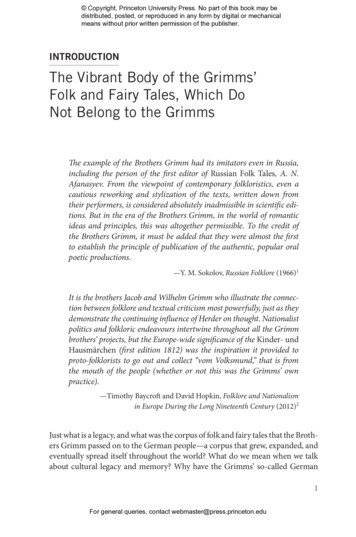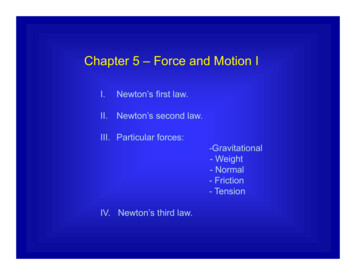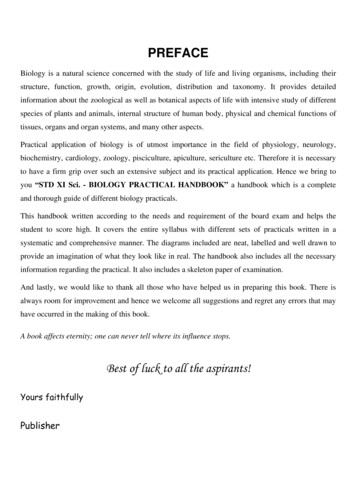
Transcription
Copyright, Princeton University Press. No part of this book may bedistributed, posted, or reproduced in any form by digital or mechanicalmeans without prior written permission of the publisher.INTRODUCTIONThe Vibrant Body of the Grimms’Folk and Fairy Tales, Which DoNot Belong to the GrimmsThe example of the Brothers Grimm had its imitators even in Russia,including the person of the first editor of Russian Folk Tales, A. N.Afanasyev. From the viewpoint of contemporary folkloristics, even acautious reworking and stylization of the texts, written down fromtheir performers, is considered absolutely inadmissible in scientific editions. But in the era of the Brothers Grimm, in the world of romanticideas and principles, this was altogether permissible. To the credit ofthe Brothers Grimm, it must be added that they were almost the firstto establish the principle of publication of the authentic, popular oralpoetic productions.— Y. M. Sokolov, Russian Folklore (1966)1It is the brothers Jacob and Wilhelm Grimm who illustrate the connection between folklore and textual criticism most powerfully, just as theydemonstrate the continuing influence of Herder on thought. Nationalistpolitics and folkloric endeavours intertwine throughout all the Grimmbrothers’ projects, but the Europe- wide significance of the Kinder- undHausmärchen (first edition 1812) was the inspiration it provided toproto- folklorists to go out and collect “vom Volksmund,” that is fromthe mouth of the people (whether or not this was the Grimms’ ownpractice).— Timothy Baycroft and David Hopkin, Folklore and Nationalismin Europe During the Long Nineteenth Century (2012)2Just what is a legacy, and what was the corpus of folk and fairy tales that the Brothers Grimm passed on to the German people— a corpus that grew, expanded, andeventually spread itself throughout the world? What do we mean when we talkabout cultural legacy and memory? Why have the Grimms’ so- called German1For general queries, contact webmaster@press.princeton.edu
Copyright, Princeton University Press. No part of this book may bedistributed, posted, or reproduced in any form by digital or mechanicalmeans without prior written permission of the publisher.2Introductiontales spread throughout the world and become so universally international?Have the Grimms’ original intentions been betrayed? Did they betray them? Ifwe fail to address these questions, the cultural legacy of the Grimms’ tales andtheir relevance cannot be grasped. This does not mean that there are right andwrong answers. Rather, the questions set a framework for inquiry that will leadto greater insight into the Grimms’ legacies, for there is more than just one thatthey bequeathed to the German people.There are several definitions of legacy in the Oxford Universal Dictionary,and the most pertinent one for my purposes concerns legacy as a bequest: “whatone bequeaths . . . anything handed down by an ancestor or a predecessor.”3 Butlegacy also carries with it a notion of binding or connecting something to someone as in the Italian verb legare— to bind, to connect, to attach. And I want tosuggest that the Grimms bound themselves to a German popular tradition ofstorytelling through the collecting of tales that belonged to the German people.Whether these tales actually belonged to the German people is irrelevant herebecause the Grimms assumed that these tales, largely gathered on Hessian andWestphalian soil, emanated from the lips of German people, primarily from thelower classes but also from the upper classes. What counts is their assumption,and what counts is their firm belief in the ancient origins of storytelling. Whatcounts is that they wanted to discover and forge a German heritage that hadgreater cultural value than they realized. The Grimms wanted to save the folkand fairy tales from extinction and to bequeath this Naturpoesie as a gift to theGerman people of all social classes. Here is what they state in the first volume ofthe first edition of 1812:We have tried to grasp and interpret these tales as purely as possible. In many of them one will find that the narrative is interruptedby rhymes and verses that even possess clear alliteration at timesbut are never sung during the telling of a tale, and these are precisely the oldest and best tales. No incident has been added orembellished and changed, for we would have shied away from expanding tales already so rich in and of themselves with their ownanalogies and similarities. They cannot be invented. In this regardno collection like this one has yet to appear in Germany. The taleshave almost always been used as stuff to create longer stories whichhave been arbitrarily expanded and changed depending on theirvalue. They have always been ripped from the hands of childreneven though they belonged to them, and nothing was given backto them in return. Even those people who thought about the children could not restrain themselves from mixing in mannerismsFor general queries, contact webmaster@press.princeton.edu
Copyright, Princeton University Press. No part of this book may bedistributed, posted, or reproduced in any form by digital or mechanicalmeans without prior written permission of the publisher.Vibrant Body of Grimms’ Tales3of contemporary writing. Diligence in collecting has almost always been lacking. Just a few, noted by chance, were immediatelypublished. Had we been so fortunate to be able to tell the tales ina very particular dialect they would have undoubtedly gained agreat deal. Here we have a case where all the accomplishmentsof education, refinement, and artistic command of language ruineverything, and where one feels that a purified literary language aselegant as it may be for everything else, brighter and more transparent, has here, however, become more tasteless and cannot getto the heart of the matter.We offer this book to well- meaning hands and thereby thinkchiefly of the blessed power that lies in these hands. We wish theywill not allow these tiny morsels of poetry to be kept entirely hidden from poor and modest readers.4And in the preface to the second volume of the first edition published in 1815,they state:Our collection was not merely intended to serve the history ofpoetry but also to bring out the poetry itself that lives in it andmake it effective: enabling it to bring pleasure wherever it can andalso therefore, enabling it to become an actual educational primer.Objections have been raised against this last point because this orthat might be embarrassing and would be unsuitable for childrenor offensive (when the tales might touch on certain situations andrelations— even the mentioning of the bad things that the devildoes) and that parents might not want to put the book into thehands of children. That concern might be legitimate in certaincases, and then one can easily make selections. On the whole it iscertainly not necessary. Nature itself provides our best evidence,for it has allowed these and those flowers and leaves to grow intheir own colors and shapes. If they are not beneficial for any person or personal needs, something that the flowers and leaves areunaware of, then that person can walk right by them, but the individual cannot demand that they be colored and cut accordingto his or her needs. Or, in other words, rain and dew provide abenefit for everything on earth. Whoever is afraid to put plantsoutside because they might be too delicate and could be harmedand would rather water them inside cannot demand to put an endto the rain and the dew. Everything that is natural can also becomeFor general queries, contact webmaster@press.princeton.edu
Copyright, Princeton University Press. No part of this book may bedistributed, posted, or reproduced in any form by digital or mechanicalmeans without prior written permission of the publisher.4Introductionbeneficial. And that is what our aim should be. Incidentally, we arenot aware of a single salutary and powerful book that has edifiedthe people, in which such dubious matters don’t appear to a greatextent, even if we place the Bible at the top of the list. Makingthe right use of a book doesn’t result in finding evil, rather, as anappealing saying puts it: evidence of our hearts. Children read thestars without fear, while others, according to folk belief, insult angels by doing this.5I have quoted extensively from the two prefaces of the first edition becausethey significantly embody the early intentions of the Grimms’ legacy of talesthat they bequeathed to the German people. What is striking, I believe, abouttheir language is their inclination to use metaphors of nature, religion, and education. This is also the language of German romanticism— idealistic and somewhat mystical. For the Grimms the folk and fairy tales were divinely inspiredand pure. They evolved organically, encapsulating human experience and behavior, and it was through the common people if not people of all social classesthat their “essential” messages were remembered and articulated. These messages contained information and truths about human experience, but they werenot didactic commandments or lessons. As I have stated in the introduction tomy translation of the first edition of Kinder- und Hausmärchen (Children’s andHousehold Tales):6 Though mindful of the educational value of their collection,the Grimms shied away from making the tales in their collection moralistic oroverly didactic. They viewed the morality in the tales as naïve and organic, andreaders, young and old, could intuit lessons from them spontaneously becauseof their “pure” poetry.In his book, Einfache Formen (Simple Forms, 1930) André Jolles claimsthat the Grimms saw a paradoxical morality in the miraculous events of folkand fairy tales alike. Jolles writes that the basic foundation of these tales derivesfrom the paradox that the miraculous is not miraculous in the fairy tale; ratherit is natural, self- evident, a matter of course. “The miraculous is here the onlypossible guarantee that the immorality of reality has stopped.”7 The readers’ interpretations of folk and fairy tales are natural because of the profound if notdivine nature of the tales, and in this sense, the Grimms envisioned themselvesas moral cultivators of a particular cultural heritage and their collection as aneducational primer of ethics, values, and customs that would grow on readerswho would grow by reading these living relics of the past and also by retelling them. In collecting and publishing the tales and all their other philologicalworks, the Grimms were actually returning “gifts” of the people through writing and print that would safeguard folk culture. In addition, their work on theGerman language and medieval literature contributed to nation building, notFor general queries, contact webmaster@press.princeton.edu
Copyright, Princeton University Press. No part of this book may bedistributed, posted, or reproduced in any form by digital or mechanicalmeans without prior written permission of the publisher.Vibrant Body of Grimms’ Tales5through politics but through a profound interdisciplinary and cultural approachto words that tied different Germanic peoples together. Not only did the tales become a great source of cultural memory, but their unusual romantic approach tophilology and literature played a great role in forging a new discipline at Germanuniversities. As Jeffrey Peck has remarked:Any critical history of Germanistik that wants to unearth its origins, especially in struggles for national identity, seems always tobegin with the Grimm Brothers. The Grimms represent in theirwork what [Hans Ulrich] Gumbrecht typifies for Romanticism:“National identity— as a representation of collective identity— seems to depend— at least for the early 19th century— on the existence of socially distant folktales and historically distant medievalcultural forms, which can be identified as the objectivations ofone’s own people.” Merely the titles of the Grimms’ publicationsreflect their preoccupation with “the German” and the Germanpast: German Legends (2 vols., 1816– 18) and their periodical OldGerman Woods (1813– 16); Jacob’s own projects, Old German Song(1811), German Grammar (1819– 37), German Monuments of Law(1828), German Mythology (1835), History of the German language(2 vols., 1848); and, of course, their well- known Fairy Tales andthe German Dictionary.8The Corpus of the TalesHere it should be pointed out that the Grimms’ tales are not strictly speaking “fairy tales,” and they never used that term, which, in German, would beFeenmärchen. Their collection is much more diverse and includes animal tales,legends, tall tales, nonsense stories, fables, anecdotes, religious legends, and,of course, magic tales (Zaubermärchen), which are clearly related to the greatEuropean tradition of fairy tales that can be traced back to ancient Greece andRome and beyond. It is because their collection had such deep roots and a broadEuropean heritage that the Grimms asserted that reading these tales would serveas an education for young and old alike. In some ways their collection was intended to be part of the European civilizing process, not just a national legacy.It was never intended for children even if it became children’s reading matter,something I shall address in chapter one.In this regard, the corpus of their collected tales was formed to change constantly and to remain alive forever as vital talking points in oral and literarytraditions. Collecting was an act of resuscitation. Editing and translating wereFor general queries, contact webmaster@press.princeton.edu
Copyright, Princeton University Press. No part of this book may bedistributed, posted, or reproduced in any form by digital or mechanicalmeans without prior written permission of the publisher.6Introductionartistic methods that guaranteed the conservation and communication of theindelible nature of the tales. Incredibly, the pulse of their tales can still be felttoday. The magic spell of their tales binds us. Here it is important to note thatthe legacy of the tales is not the only legacy that the Grimms bequeathed to theGerman people. One could also study their other legacies with regard to legends ( Deutsche Sagen, 1816– 18), myths (Deutsche Mythologie, 1835), linguistics(Deutsche Grammatik, 1819– 37, and Deutsches Wörterbuch, 1854– 63), and jurisprudence (Deutsche Rechtsaltertümer, 1828). For some scholars, the Grimms’greatest achievement was the creation of the first great German Dictionary, butit would be foolish to try to single out the Grimms’ most important contributionto the German cultural heritage. Overall their philological, aesthetic, legal, andethical concerns coalesced in the Kinder- und Hausmärchen that absorbed themfrom 1806 until their deaths in 1859 and 1863.In Jens Sennewald’s highly significant study, Das Buch das wir sind (“The BookThat We Are”), he explores and explains the intentions and concepts developedby the Grimms as romantic writers and philologists just as Jacob had sought overtwo hundred years ago to clarify their beliefs and methods to the writer Achimvon Arnim,9 their friend, who provided the contact to Georg August Reimer, thepublisher of the first edition of Kinder- und Hausmärchen in 1812. Sennewaldemphasizes that we must bear in mind that there was not just one edition of theirlarge collection of tales, but seven, and that the narratives, consisting of fairy tales,animal tales, legends, religious stories, fables, tall tales, and anecdotes, were constantly edited and changed over the course of forty- seven years. These seven largeeditions were part of the Grimms’ other linguistic and philological works. Giventhe Grimms’ great erudition and aesthetic concerns, Sennewald maintains thatthe tales in all the editions need to be considered as a collective whole becausethese stories, according to the Grimms, originated in antiquity and continued tobe formed and reformed in a flowing process of retelling and remaking that enabled words to come alive and remain alive as part of the popular cultural memory. Indeed, the Grimms wanted to resuscitate relics and muted words of the pastso that they could speak for themselves. As part of the process, the Grimms sawthemselves as excavators and cultivators, who sought to make the past livable forGerman people of all social classes and enable them to become at one with thewords of the tales. This task that the Grimms set for themselves demanded greatartistry and philological knowledge. Sennewald remarks:The poetry of the Kinder- und Hausmärchen is the result of theirauthorship of a “romantic book.” Their poetics is stamped by philological poetry: at each turn of speech the “prevailing mark” ofthe philologists is at work who produced highly poetical texts andFor general queries, contact webmaster@press.princeton.edu
Copyright, Princeton University Press. No part of this book may bedistributed, posted, or reproduced in any form by digital or mechanicalmeans without prior written permission of the publisher.Vibrant Body of Grimms’ Tales7permanently concealed this singular achievement. . . . The K inder- und Hausmärchen, collected by the Brothers Grimm became a“book that we are” through their poetics. The “we” of this bookis one of brotherhood, of the “collaterals,” as Jacob Grimm wrote.The figures of the Kinder- und Hausmärchen, the female informantand the collector represent a “folk widely speaking,” and it seems asif the closed collection, read as ethnographical record, reaches waybeyond the borders of the book. Whoever turns to the tales of the“folk” after reading the Kinder- und Hausmärchen will find what lethim turn to the tales: the structures and regularity of a “romanticbook.” A research of folk tales that connects itself to the K inder- und Hausmärchen and dedicates itself to finding “original” folktales that correspond to the “instinctual doings of nature” followsthe prescribed tracks of the Kinder- und Hausmärchen.10The binding element and memetic appeal of the Grimms’ legacy is, in myopinion, as strong and as necessary as Sennewald states, and research must account for the widespread reception of their collected tales throughout the world.Legacies are not just bequeathed but require an active chain reaction from generation to generation. They demand accountability of reception. They require thatone knows and appreciates the value of the offering or gift, who gave it, and why.Consequently, research into the corpus of the Grimms’ legacy must include somebasic acknowledgment of the tales’ history and how they contributed to the tradition of European folklore and to the study of world folklore. In my opinion, someof the following fundamental aspects of their work and lives are helpful in appreciating their legacy of tales and how this legacy spread beyond German borders:1. Although the Grimms collected folk songs, poems, and tales before 1807,they became more focused on prose tales at this time and expanded thisfocus up through 1810 to assist Clemens Brentano, a talented romantic writerand poet, who wanted to adapt oral tales for a book of literary fairy talesthat he was planning to publish. The Grimms dutifully sent him fifty- fourtales. However, Brentano did not like the Grimms’ stories and left behindtheir manuscript in the Ölenberg Monastery in Alsace. By chance the tales,now called the Ölenberg manuscript, were discovered in 1920. Ever sincethis discovery researchers have been able to study the manner in which theGrimms began editing and honing the tales.11 Moreover, as Vanessa Joosenhas demonstrated,12 the Ölenberg manuscript provides the basis not onlyfor understanding the Grimms’ process of retelling tales but also serves asa case study of intertexuality and how contemporary writers have followedFor general queries, contact webmaster@press.princeton.edu
Copyright, Princeton University Press. No part of this book may bedistributed, posted, or reproduced in any form by digital or mechanicalmeans without prior written permission of the publisher.8 Introductionin the Grimms’ footsteps, so to speak, and developed a dynamic process ofretelling fairy tales that enriches the Grimms’ legacy.2. In 1812 Achim von Arnim— another significant romantic writer and friendof Brentano— advised the Grimms to publish the tales they had sent to Brentano along with many new ones that they had collected. Although Arnimhad differences with the Grimms when it came to judging modern literature,he had great faith in their project and was a strong proponent of collecting folk material. As a result, the Grimms not only produced one edition oftheir tales but also published seven different editions of their large collection(called the große Ausgabe) from 1812 to 1857, including different prefaces,essays, and scholarly notes, which were first published together with thetales of the first edition and later in separate volumes of 1822 and 1856.There were many unusual variants of the tales in the notes that reveal theGrimms’ extraordinary knowledge of different genres of orality and literature throughout the world. Some of the tales in the notes were replaced byother versions in the final edition or published elsewhere. By the final publication of the 1856 edition of the notes, there were many new tales as well asnumerous variants and rough drafts in their posthumous papers.3. In addition to the Large Edition there were ten different printings of theirSmall Edition (called the kleine Ausgabe) published from 1825 to 1858. Thetales in the Small Edition were carefully selected by Wilhelm Grimm to appeal to bourgeois children and their families and included six illustrationsby their brother Ludwig Grimm, a painter. There were no prefaces, notes,or long essays in the ten printings of the Small Edition. The intention herewas to popularize their tales and to appeal to a growing reading public ofchildren and their families.4. The posthumous papers of the Grimms contain a large quantity of tales thatthe Brothers received from friends and colleagues or collected themselves.For some reason or other, they did not want to use these tales in the published corpus of their collections. Heinz Rölleke has reproduced many ofthese interesting tales in Märchen aus dem Nachlaß der Brüder Grimm,13 andthere have been several other books of omitted or deleted tales publishedfrom the Grimms’ posthumous papers that are worth examining as part ofthe Grimms’ legacy, including an English translation and tales that appearedin journals and magazines but are not the same as those published in thelarge editions of the collection.145. Although the Grimms maintained that they did not alter the words of thetales that they collected from the lips of their informants, and that all theirFor general queries, contact webmaster@press.princeton.edu
Copyright, Princeton University Press. No part of this book may bedistributed, posted, or reproduced in any form by digital or mechanicalmeans without prior written permission of the publisher.Vibrant Body of Grimms’ Tales9tales stemmed from the oral tradition, none of this is true. A simple comparison of the tales in the Ölenberg manuscript of 1810 with the tales in the firstedition of 1812/15 reveals that the Grimms made or had to make substantial changes because it was difficult for them and their contributors to copydown on paper the exact words of the tales that they heard. Moreover, theGrimms also began adapting tales from books published from the fifteenththrough the eighteenth century. In short, none of their tales could ever bedesignated as “pure,” “authentic,” or “original.” The Grimms actually knewthis, and yet they used those terms because they believed their tales bore thetraces of a profound oral tradition. They felt justified to proclaim that theirtales were “genuine” and “pure” because the changes that they made werebased on their understanding of the “natural” poetics of oral storytelling,and the more they did research about the oral tradition, the more they feltconfident in their skills as writers to re- present the unique elements of traditional stories. Incidentally, most collectors worked this way in the eighteenthand nineteenth centuries.6. During the first phase of their collecting tales from 1806 up to approximately1817, Jacob Grimm was the dominant figure and more or less establishedthe principles of their collecting and recording of tales. For instance, morethan 60 percent of the tales in the Ölenberg manuscript are in his handwriting, and it is apparent from letters, prefaces, and essays that his ideologicalthinking set the tone for their project that he developed collectively with hisbrother, other interested scholars, and friends. Both Brentano and Arnimwere enthusiastic about the Grimms’ desire to collect oral folk tales and publish them either in a journal or book dedicated to old German literature. Ina long letter to Brentano, written on January 22, 1811, Jacob composed anappeal, “Aufforderung an die gesammten Freunde altdeutscher Poesie undGeschichte erlassen” (“Appeal to All Friends of Old German Poetry and History”),15 which spelled out the initial premises of the Brothers’ project andtheir intense engagement to foster a greater understanding of popular German culture. Here are some of the emphatic romantic ideas from this letterthat were to underlie all their work on folk and fairy tales:We are going to start by collecting all the oral tales from the entireGerman fatherland and only wish that we do not misconstrue thegeneral and extensive sense of the matter by the manner in whichwe are approaching it. We are thus going to collect each and everytradition and tale of the common man whether the contents besad or humorous, didactic or amusing, no matter what the timeFor general queries, contact webmaster@press.princeton.edu
Copyright, Princeton University Press. No part of this book may bedistributed, posted, or reproduced in any form by digital or mechanicalmeans without prior written permission of the publisher.10Introductionperiod is, whether they have been composed in the simplest proseor set in rhyme. . . .Isn’t folk poetry (Volkspoesie) the vital lifeblood that is drawnfrom all the deeds [of the German people] and continues to existfor itself? And mustn’t it do so because otherwise no history wouldreach the folk and no other kind of history would be used by thefolk? . . .We especially mean here the fairy tales, the evening conversations, and the stories from the spinning rooms, and we know twokinds of things very well. Names held in contempt and things thathave been ignored until now continue to stick in each and everyhuman mind from childhood to death. Consequently, we thinkthat even in the locked- up energy of the special social classes, likebeneath the cool shadow of the tree, that the source of tales cannotvanish, while whatever lies in the middle, where the general heatof the sun flows, has long since been dried out. Certainly, amongold craftsmen, silently working miners, and the green free foresters and soldiers many peculiarities and particular ways of conversing and telling stories, customs and manners have continuedto be maintained, and it is high time that they are collected beforethey are completely extinguished or new forms of those traditionshave their meaning torn away from them. . . .Now we want to record all this as faithfully and literally aspossible, with all the so- called nonsense that is easy to find but always even easier to cast off than the artificial reproduction whichone would want to try instead of keeping the nonsense.16The ideas in this private letter to Brentano, read and approved by Wilhelm,were more fully developed later in the Circular wegen der Aufsammlung derVolkspoesie (Circular- Letter Concerned with Collecting of Folk Poetry) printedand distributed in 1815. It is worth citing this circular- letter, once again conceived by Jacob, because it outlines the basic principles and intentions of theGrimms:Most Honored Sir!A society has been founded that is intended to spreadthroughout all of Germany and has as its goal to save and collectall the existing songs and tales that can be found among the common German peasantry (Landvolk). Our fatherland is still filledwith this wealth of material all over the country that our honestFor general queries, contact webmaster@press.princeton.edu
Copyright, Princeton University Press. No part of this book may bedistributed, posted, or reproduced in any form by digital or mechanicalmeans without prior written permission of the publisher.Vibrant Body of Grimms’ Talesancestors planted for us, and that, despite the mockery and derision heaped upon it, continues to live, unaware of its own hiddenbeauty and carries within it its own unquenchable source. Ourliterature, history, and language cannot seriously be understoodin their old and true origins without doing more exact researchon this material. Consequently, it is our intention to track downas diligently as possible all the following items and to write themdown as faithfully as possible:1. Folk songs and rhymes, that are performed at different occasions throughout the year, at celebrations, in spinning parlors, on the dance floors, and during work in the fields; firstof all, those songs and rhymes that have epic contents, that is,in which there is an event; wherever possible with their verywords, ways, and tones.2. Tales in prose that are told and known, in particular the numerous nursery and children’s fairy tales about giants, dwarfs,monsters, enchanted and rescued royal children, devils, treasures, and magic instruments as well as local legends that helpexplain certain places (like mountains, rivers, lakes, swamps,ruined castles, towers, stones, and monuments of ancienttimes). It is important to pay special attention to animal fables, in which fox and wolf, chicken, dog, cat, frog, mouse,crow, sparro
(1828), German Mythology (1835), History of the German language (2 vols., 1848); and, of course, their well-known Fairy Tales and the German Dictionary.8 The Corpus of the Tales Here it should be pointed out that the Grimms’ tales are not strictly speak-ing “fairy tales,” and they never used t










